 In this Swing Check we look at the swing of Xavier Augustyniak (known on the forum as The Rambler).
In this Swing Check we look at the swing of Xavier Augustyniak (known on the forum as The Rambler).
Xavier carried an 11.3 index at the time these video clips were taken. He describes his mis-hits as going far to the right and his contact being both off the heel and the toe. He says his swing thoughts are to keep his head and body down and his left arm straight.
As we examine his swing we’ll look at how other things are the causes of lifting out of the shot and why the bending of the target side arm shouldn’t be a concern. By the end of the article you should never have to think about keeping your head down or left arm straight again, and you should have an understanding of what leads to those occurrences (and how to correct for them).
Setup
In Xavier’s iron setup, shown from the face-on view, we see good stance width, the upper spine tilted slightly away from the target, and the ball positioned in line with the front ear – all of which are good positions we see in the setup of the pros. The major area that differs from the pros in this view is the shaft angle. Some golfers mistakenly believe that setting up with the hands in front of the ball will encourage the hands to arrive in front of the ball at impact, but that’s not true. Forward pressing leads to a couple of problems. The shoulders tend to re-align to the left of the intended target, the upper left arm may become disconnected from the upper left chest area, balance may be compromised, the arms may be encouraged to over rotate, and the club is encouraged to swing under and inside the original shaft plane at the start of the swing.
As we can see in the image below Charles Howell III has the shaft straight up and down (perpendicular to the ground) pointing in the area of of the target side of his face (also where you commonly find logos on golf shirts). This setup position helps Howell to make a good start to the backswing.
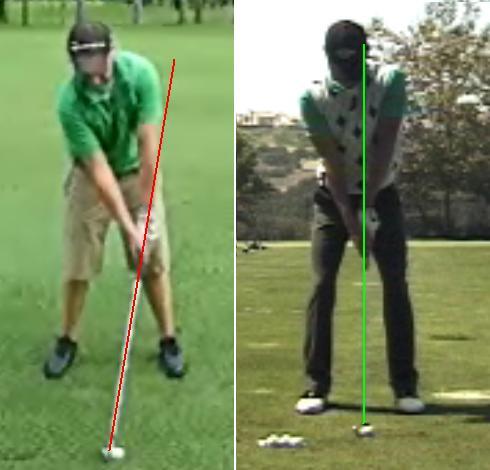
In the down-line setup Xavier looks too bent over (at the waist) with the upper body, and too far away from the ball. This can be seen from the blue line drawn through the club shaft at address (pointing up toward the stomach), and the red balance line (where the edge of the shoulders is far right of the line). These positions will lead to problems with balance and posture during the swing, and the club swinging off path and plane.
Standing too far away from the ball and too much bend (toward the ball) can lead to the body blocking the arms (which can cause a collapse of the arms), cause the hips to pull under the body during the swing, and lead to raising out of posture. If you think you have problems raising out of the shot (or the arms running into the body) look to your setup (posture) as the cause before you look to the swing.
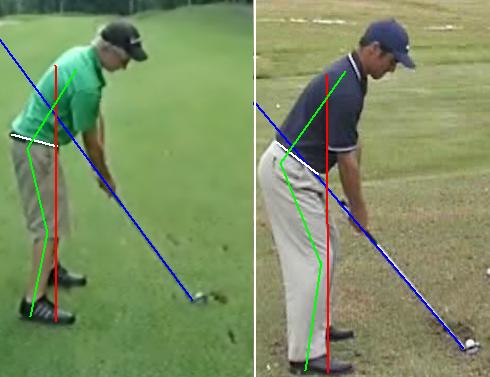
In summary with the majority of pros we see:
- Shaft straight up and down at address from the face on view (which helps with shoulder and eye alignment seen in a down-line view).
- Upper arms close to the side of the upper chest (since there is no forward press puling the arms away from the chest).
- Belt line (shown by Trevor Immelman above) matching or close to parallel with the shaft plane angle at address, notice how that helps create a right angle between the spine and shaft, setting the body in good position to rotate in a way that keeps the club swinging on plane.
- Edge of shoulders, kneecaps, and balls of the feet stacked in line from the down-line view establishing good balance, posture, and arm hang that lacks tension (shown by Immelman).
Backswing
As Xavier swings back the club swings underneath the original shaft angle plane and behind the body. Things that influenced this motion include: the high shaft angle at address, standing far away from the ball, bending from the waist as opposed to the hips (see how the belt line is nearly horizontal to the ground), and the slight disconnection between the left arm and the side of the chest.
With the golf pros we see the club start back on the original shaft angle plane (down line view) as a result of:
- Good balance and posture with the edge of the shoulders in line with the kneecaps and balls of the feet (downline view).
- Position of the club shaft, hands, and arms at address (face on view).
- Alignment of the shoulders and hips (parallel to the target line) at address (down line view).
- Left arm staying close and swinging in sync with the upper left chest area at the start of the backswing.
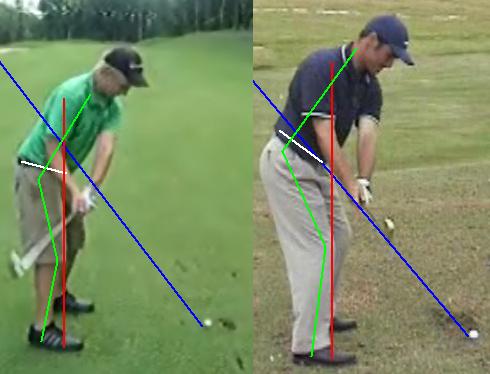
By the time the left arm has reached parallel to the ground on the backswing the club has swung deep behind Xavier’s body (shown above). This is a result of hip high back position, the setup, and is further encouraged by the rear leg straightening and the right hip turning nearly as much as the shoulders in the backswing.
From the down the line view we see that the hips are turning relatively horizontal to the ground, which was established at address (the belt line tilt, or lack thereof shows us both the hip tilt and the direction of body motion). When the arms swing deep behind the body, and the shaft adopts a flat angle (like we see in Xavier’s swing) the muscles in the arms and hands tense up, and the club may feel heavier (requiring th muscles in the arms, hands, and shoulders to work harder and swing slower).
Xavier has done a good job of having the arms swing back in sync (speed wise) with the turning of the chest. (This can be seen better in video than still pictures). If Xavier’s body stopped turning and the his arms kept swinging we might see a breakdown of the left arm (the arms hit a proverbial wall and a loss of the straight left arm could occur). If you feel your left arm is collapsing during the swing you may benefit from checking the synchronization of your arm swing and body turn during the backswing instead of worrying about trying to keep the left arm stiff and straight. If you have a slight bend your still in good company as major winners like Nick Price and Retief Goosen (shown later) have a slight bend in the lead arm duing the swing.
Since the tour pros have their clubs swinging on (or close) to the shaft plane established at address (downline view) the club arrives in a position more in front of the chest when the lead arm reaches parallel to the ground in the backswing. With tour pros we see the hip rotation on a plane that matches the belt line established at address. That hip angle and rotation also helps to keep the club from swinging, too far, behind the body.
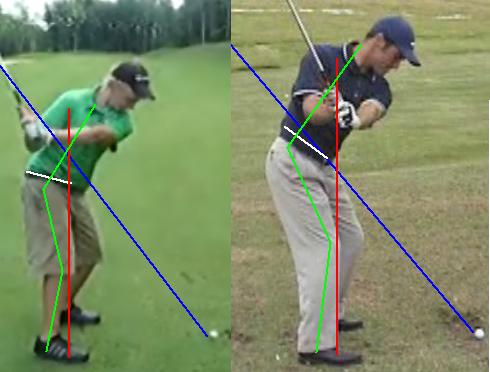
Top of Swing
At the top of the swing Xavier has arrived at a position where his left arm is parallel to the belt line, and significantly flatter than the original shaft angle plane.
When the pros arrive at the top of the swing we also see their left arms in a position parallel to their belt angles (downline view), but since the hips were tilted on a steeper angle at address (and had less rotation) we see a higher (more vertical) left arm position at the top of tour pro swings.
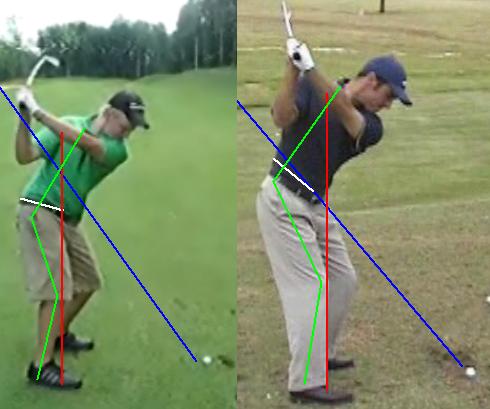
Downswing
Left arm parallel down: When the left arm has arrived parallel to the ground on the downswing we see that most of Xavier’s body on the right side of the balance line (red line in down the line view). This matches up with what we saw at address (where more of his body is on the right side of the line). This indicates weight may be favoring the toes, and that his body is likely to block the swinging of his arms on the way to impact.
When we look at tour pros we see a more equal distribution of body mass to the left and right sides of the balance line (downline view). From here balance is easy to maintain, and the arms have room to swing down to impact with out the body hindering their path.
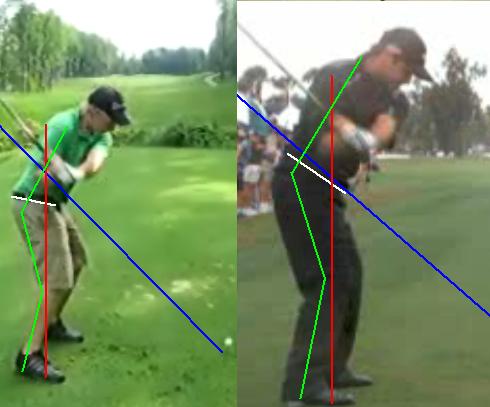
Impact
At impact we see Xavier has lost his posture and his balance. (Notice how his hips have pulled in closer to the ball then they were at setup, and how he has already risen on to his rear toes). The loss of balance and posture makes it very difficult to arrive at a consistent impact position.
At impact the pro do a good job of maintaining their balance and posture, and as a result they are able to efficiently transfer energy to the ball instead of expending it to make compensations. (Immelman’s heel has stayed low to the ground showing that his legs are supporting the body instead of driving ahead of it. While the edge of the shoulders remaining stacked in line with with the knee caps and balls of the feet show Immleman has maintained good balance).
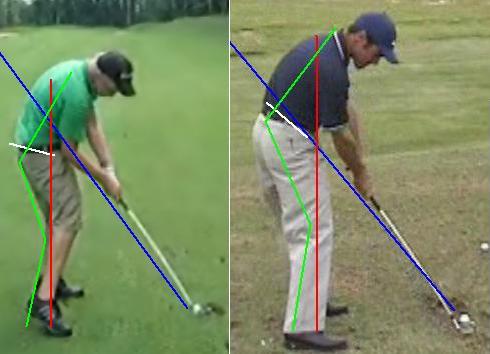
From the driver face on view we can see that Retief Goosen’s left arm is not straight at impact which shows that a straight left arm isn’t necessary for long drives (300+ yards), nor to be a great ball striker and win multiple majors. 😉
(Goosen doesn’t have as much bend now in the left arm, as he did when the his swing was captured above. Goosen has gone on record as saying it is a result of better posture and rhythm).
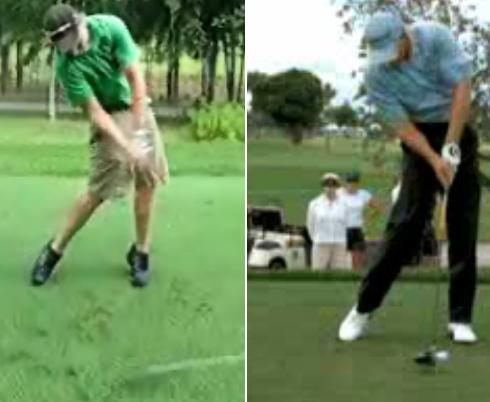
Conclusion
In summary Xavier will see fast improvement if he makes a few adjustments at setup (set the shaft, hands, clubhead in a straight line -face on view-, and good posture -down line view-). The improved setup will automatically improve many of his swing positions. 🙂
If you’re interested in having your swing analyzed in a future edition of Swing Check here on The Sand Trap, check out the requirements page and submit your videos today!

One warming I would give about a bent arm though. Too much of a bent arm can cause you to top the ball or miss it completely. I’ve had this problem where the arm is bent at the top and never straightens in the downswing. This has caused many embarrassing tops and misses with the driver.